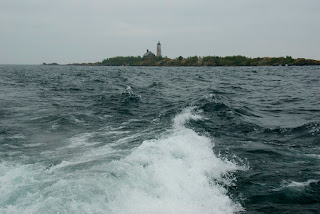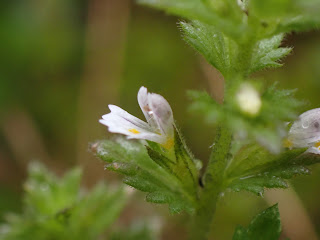Author’s Note: I’m traveling quite a bit over the next month, which means I’ve been reminiscing about past trips. As I jet off to raft the Grand Canyon with a photography workshop, here’s a story from 2015 about my family trip to Isle Royale National Park. Unlike the Colorado River, Lake Superior doesn’t need rapids to make big waves. Enjoy! -- Emily
We heaved our backpacks, loaded with high-energy foods, waterproof tents and warm clothing, onto the ferry dock just as the gray dawn was beginning to break. Waves crashed around the Voyageur II, and gusts of damp wind threatened to steal our hats. The ferry captain came out to greet us, passenger list in hand. We collectively expected him to say something like “All aboard!” Instead, with a bemused smile, he projected his voice over the bluster to the waiting crowd and said “We’re not going.”
At first there was just stunned silence, with a few hesitant chuckles, since he looked like he might appreciate a good joke. But he wasn’t joking, and neither was Lake Superior. Eight-foot waves and 30 mph gusts across a 20 mile expanse of cold, open water are nothing to mess with. “This is your one chance for a refund,” he said, “otherwise be here by 4:45 a.m. tomorrow.”
So, for plan B we headed up to the Grand Portage National Monument Visitor Center. The park ranger at the front desk didn’t miss a beat when we told him of our delayed departure to Isle Royale. “Welcome to a long tradition of people waiting at Grand Portage for good enough weather to start a journey on Lake Superior.”
The voyageurs who rendezvoused here every summer through the height of the fur trade era called Lake Superior “The Lady.” And this Lady makes her own rules. Icy water, big winds, and craggy rocks don’t make for safe or easy travel. Gardens of shipwrecks can attest to that. But rising out of the crystal clear water, 14 to 20 miles from shore, is a bit of an anomaly. Isle Royale, a 45 mile long and 9 mile wide bedrock island, is teeming with life that somehow made the treacherous journey.
 |
| The cold, clear waters of Lake Superior separate Isle Royale and all its life from their counterparts on the mainland. The Lake makes the Island. Photo by Emily Stone. |
The next morning, with the rough, rolling, cold, wet ferry ride behind us, we disembarked gratefully at the Windigo dock on the southwest corner of the island, joining the many lives already there. After cooking oatmeal in the campground, we hoisted our packs and started off down the trail.
Before long, we met several pairs of hikers just ending their trips. We asked about their route on the island, their hometown, and which ferry they took. In essence, we asked “How did you get here?” Mostly they used the water route, but one couple arrived by air in a float plane. Historically, making winter crossings by dogsled was also common. Isle Royale is not an easy place to get to, or to get around, and yet life surrounded us on all sides. Soon I started asking “How did you get here?” to everything we saw.
While relatively few humans arrive on the island by air, many of the island’s wild residents and visitors arrived that way. The haunting wails of loons drifted up from every lake we passed. Chickadees chattered above us as we hiked, while flocks of cedar waxwings played follow-the-leader between berry-laden mountain ash trees. It’s not hard to imagine how the birds got here, or how the seeds of their favorite fruits got here either.
Fruit-bearing shrubs like chokecherry, mountain ash, and serviceberry are often pioneering species, since their seeds are air-dropped in a packet of fertilizer. The vibrant, red fruits of thimbleberry caught our attention, too, and supplemented our quick breakfast. Slowing down to pick berries left us open to attack, though, from the delicate mosquitoes who once made the dangerous crossing, too.
While the whine of mosquitoes was pleasantly rare, red squirrels scolded us incessantly. A water route seems like the only plausible explanation for the squirrels’ presence. Did the first squirrel on the island drift here on a fallen tree or raft of vegetation? What a frightening ride without a motor, rudder, rain gear, warm sweater, or pack full of food! How many attempted journeys failed – with no refund!? Now the red squirrels have been here so long – separated from the mainland population by that arduous journey – that they are considered their own subspecies: Tamiasciurus hudsonicus regalis.
Not just a scolding, but a crashing in the brush caught our attention. Through the dense spruce trunks we caught a glimpse of the hulking silhouette of a cow moose as she vanished into woods. Moose are thought to have swum here from Canada around 1900 during a time of overpopulation on the mainland. And they didn’t have a bowl of warm oatmeal to greet them at the end. The trees they browse were here already, though, having colonized the island (by air or water?) shortly after the glaciers retreated 11,000 years ago.
Having sighted one of the iconic species of Isle Royale, we were now on the lookout for the other: wolves. Large, hairy scat on the trail signaled their presence, as did a few big, four-toed tracks among the boot prints on muddy trails. With only two or three wolves left on the island, that is more sign than I’d dared to hope for. Wolves likely crossed the ice bridge in the winter of 1948-49, and they helped stabilize the moose population for many years. Update: In 2018 and 2019, the National Park Service brought in wolves to help buoy the population. The NPS estimates that 30 wolves now live on the island.
Air, water, ice. It is almost easier to imagine how the 1.1 billion year-old bedrock of this island formed than to imagine how such a diversity of seemingly fragile organisms came to colonize it. Perhaps most telling is that not everything did make it. Bears, raccoons, skunks, porcupines, cottontails, and snapping turtles are notably absent. For humans, too, Isle Royale National Park is one of the least-visited parks in the country, and one of the most costly to visit (measured in time, money, and the discomfort of seasickness). Perhaps I’m biased, but I think that makes the creatures who do get there a little more special.
Emily’s award-winning second book, Natural Connections: Dreaming of an Elfin Skimmer, is available to purchase at www.cablemuseum.org/books and at your local independent bookstore, too.
For more than 50 years, the Cable Natural History Museum has served to connect you to the Northwoods. The Museum is open with our brand-new exhibit: “Anaamaagon: Under the Snow.” Our Fall Calendar is open for registration! Follow us on Facebook, Instagram, YouTube, and cablemuseum.org to see what we are up to.













.JPG)




